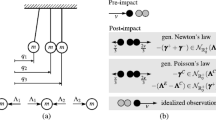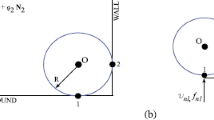Abstract
It is shown how some recent general theoretical results on impacts of mechanical systems with unilateral constraints, obtained by means of Differential Geometric Impulsive Mechanics, can be operatively applied to the study of impacts between rigid bodies. The applicability of these geometric techniques is partly discussed for general impacts of rigid bodies. In particular, the general aspects of the algorithm are described and applied to analyze the impacts of two equal billiard balls moving on the plane in all possible ideal situations: when the balls can freely slide or roll on the plane of the billiard and/or between themselves. The use of symbolic-computation software is indispensable to solve the computational difficulties arising because of the high number of degrees of freedom of the system. It allows to obtain explicit expressions for the post-impact linear and angular velocities of the balls, and therefore a complete quantitative and qualitative analysis of any particular ideal impact with assigned pre-impact positions and velocities. The data regarding the usual billiard impact with the object ball at rest are explicitly listed and illustrated.
Similar content being viewed by others
References
Pasquero S (2005) Ideality criterion for unilateral constraints in time-dependent impulsive mechanics. J Math Phys 46(11): 112904
Pasquero S (2006) On the simultaneous presence of unilateral and kinetic constraints in time-dependent impulsive mechanics. J Math Phys 47(8): 082903
Pasquero S (2008) Nonideal unilateral constraints in time-dependent impulsive mechanics: a geometric approach. J Math Phys 49(4): 042902
Stronge S (2000) Impact mechanics. Cambridge University Press, Cambridge
Brogliato B (1996) Nonsmooth impact mechanics. Models, dynamics and control. Lecture notes in control and information sciences 220. Springer, New York
Kane TR, Levinson DA (1987) An explicit solution of the general two-body collision problem. Comput Mech 2: 75–87
Domenech A (2008) Non-smooth modeling of billiard- and superbilliard-ball collisions. Int J Mech Sci 50: 752–763
CoCoA Team. Cocoa: a system for doing computations in commutative algebra. http://cocoa.dima.unige.it
Crampin M, Pirani FAE (1986) Applicable differential geometry. Lecture notes series 59. London Mathematical Society, Cambridge
de Leon M, Rodrigues PR (1990) Methods of differential geometry in analytical mechanics. North Holland, Amsterdam
Pasquero-Link (2008) A computer assisted geometric approach for the analysis of the impact of billiard balls: ideal impacts data. http://www2.unipr.it/~passte25/Pubblicazioni.html
Salazar A, Sanchez-Lavega A (1990) Motion of a ball on a rough horizontal surface after being struck by a tapering rod. Eur J Phys 11: 228–232
de la Torre Juarez M (1994) The effect of impulsive forces on a system with friction: the example of billiard game. Eur J Phys 15: 184–190
Author information
Authors and Affiliations
Corresponding author
Rights and permissions
About this article
Cite this article
Pasquero, S. A computer-assisted geometric approach to the analysis of the impact of billiard balls. Part I: Ideal impacts. J Eng Math 69, 373–384 (2011). https://doi.org/10.1007/s10665-010-9405-9
Received:
Accepted:
Published:
Issue Date:
DOI: https://doi.org/10.1007/s10665-010-9405-9




